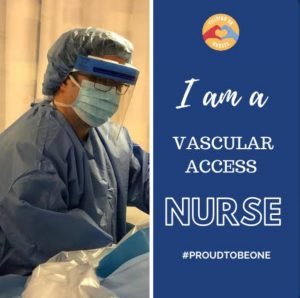VASCULAR ACCESS NURSE
Are you interested in knowing more about vascular access nurse? If so, then you are on the right page. Feel relaxed and make sure you read the article to the end.

In general, a Vascular Access Nurse provides access to a patient’s circulatory system through the insertion of a small, thin tube called a catheter. The degree of complexity of the catheter (aka, the Vascular Access Device (VAD)) in the body can range from IVs, Peripheral IVs (PIVs), and Midlines, contained in the arms, all the way to Central Venous Catheters (CVCs), including Peripherally Inserted Central Catheters (PICCs), Axillary lines, Internal Jugulars (IJs) and Femoral lines (Fems). CVCs are inserted either in the arm (e.g., PICC) or in the central part of the body (chest, neck, or leg) and end in the large veins leading to the heart such as in the Superior Vena Cava (SVC) or Inferior Vena Cava (IVC). The venous access allows efficient and safe delivery of medications and therapies to the body, and some allow blood draws. Most Vascular Access Nurses receive training for IVs, PIVs, Midlines and PICCs but not for advanced procedures (e.g., small bore and large bore lines).
The Vascular Access Nurse follows the prescribed directions from the managing physician and may collaborate, depending on his or her expertise. The medical team considers the patient’s clinical history and needs when determining the appropriate VAD. Some Vascular Access Nurses may also monitor the patient and maintain the catheter.
A Mobile Vascular Access Nurse works for a company that specializes in vascular access procedures. Most nurses for mobile vascular access companies are 1099 contractors (as compared to W-2 employees) and travel to various healthcare settings to provide vascular access services for the patients of the company’s clients. They are usually competent for IVs, PIVs, Midlines and PICCs like other Vascular Access Nurses and not for the advanced CVCs (e.g., small bore and large bore lines) like most of the Mobile Vascular Access Nurses at Vascular Wellness. The Mobile Vascular Access Nurses at Vascular Wellness are certified and insured W-2 employees, have superior and extensive training, and can place the most advanced lines and as such, are referred to as Vascular Access Clinicians.
Contents
What training is required for a Vascular Access Nurse?
The training required for a Vascular Access Nurse is generally not taught in nursing schools other than the basic PIV, and must be learned from experienced clinicians, either at a hospital or outside classes. Most nurses join vascular access teams and departments to acquire the knowledge needed to perform Midlines and PICCs and a select few may learn the advanced CVCs, such as small bore and large bore lines. In general, Mobile Vascular Access Nurse companies may require their contractors and employees to have further training and competencies as they are solo in the field with limited support.
The orientation process at Vascular Wellness is geared to the individual and involves classroom training and monitored, hands-on, training in the field. As it is individualized, training varies depending on the skill set the individual possesses at time of hire or training as ongoing skill verification and training is required. This involves Ultrasound (US) training, PICC and Midline training, and when proficient, more advanced lines like IJs and Fems. The advanced training required to place IJs, Fems, and Large Bore lines, a CVC that can be used in dialysis, is usually not available at the hospital or most mobile vascular access companies.
Vascular Wellness training can be challenging and generally consists of anywhere from 50 to 100 lines per vascular access clinician per type of Vascular Access Device to maintain Vascular Wellness’ high standards; however, once a clinician is fully trained, he or she will feel fully competent and confident in the field. It can be difficult to obtain this level of training in a busy hospital setting or other mobile vascular access companies, as they generally train to less than 15 lines per procedure prior to sending a clinician solo. Of note, estimates are that about only 1% of all registered nurses are competent to successfully perform and provide Vascular Access procedures above the complexity of the Peripheral IV.
Where do Vascular Access Nurses work?
Traditional Vascular Access Nurses primarily work in hospitals. They may work in teams or pairs and may have training up to PICCs. While a select few may have more advanced training such as on IJs and Fems, usually, managing physicians including interventional radiology place the advanced lines.
Mobile Vascular Access Nurses work for an external company and perform vascular access procedures for the patients of the company’s clients, which then become joint patients. As a mobile professional, the nurse providing vascular access may do so in various medical settings such as hospitals, long term acute care facilities, surgical centers, and skilled nursing facilities and involve many staff and patients. For many, it is exciting to have each day be different, build a rapport with staff and patients alike, and be valued for this vascular access expertise. At Vascular Wellness, we serve clients in a variety of ways including as the facility’s sole vascular access team, the facility’s staff augmentation team for high caseloads, attrition, staff vacation and other times of need, and the facility’s experts on call when the facility’s core team needs additional help. For example, we get called when a facility’s core team cannot obtain vascular access after many attempts and needle sticks, and our clinicians come to the challenging situation and obtain the much needed vascular access – for which our team gains much admiration and respect for a job well done. We also serve clients through program development, policy documentation, infection control consulting, and education and training.
What is it like being a Mobile Vascular Access Nurse at Vascular Wellness?
As a Mobile Vascular Access Clinician employee (with comprehensive benefits) at Vascular Wellness, you will be the sole representative serving the client and patient. You are the client ambassador as well as the medical clinician and you must be able to perform both roles at the highest levels. You will have access via technology, such as mobile apps, to the Vascular Wellness team and the team will support you along the way. If you enjoy the challenge and opportunity of serving these roles and have clinical, communication, analytical, and people skills, you will both enjoy and have success in this career.
There are some characteristics of the job to consider. Some days, you may have free time within your shift hours that allow you to run errands or attend to personal matters and other days you may have cases stacked up or cases that run beyond your shift hours and you are expected to serve as many as possible We do triage like other medical providers when possible but ultimately, we are here to serve both our clients and patients and provide extraordinary service and care. Typically, you will drive from 100 to 300 miles a day and only you can decide how you feel about this amount of driving. Some clinicians enjoy having time to make phone calls and listen to podcasts and others, would rather have less time in the car. Time in the car does vary per clinician and per territory and thus, do not let this aspect deter you from exploring a Mobile Vascular Access career.
How is Vascular Wellness a leader in the Mobile Vascular Access field?
Vascular Wellness focuses on vascular access, and we ensure that our clinicians are and remain the top experts in this highly significant medical field. Our advanced training covers all procedures, X-Ray reading, and needle visualization using US guidance with ECG technology, which is core to our approach. We also use the Modified Seldinger technique (MST) on small bore line placement and the Seldinger technique (ST) on large bore line placement, which isn’t utilized by many Traditional or Mobile Vascular Access Nurses. This allows proper line placement as well as evaluation of the health of the vein. If, for example, there is some narrowing of the vein on the US, the clinician can have the managing physician evaluate it for a potential deep vein thrombosis (DVT) aka, a clot. It is the totality of this advanced training and equipment proficiency that allows us to treat a wide patient population such as infants and the elderly as well as patients that are obese, contracted or have kidney disease. As a result, Vascular Wellness improves patient outcomes across a wide spectrum with less clotting, infections, and other adverse events.
READ ALSO:MEADOWS CENTER FOR NURSING AND HEALING
Vascular Wellness advances healthcare and empowers nurses and one such example is our innovative Large Bore program, which was approved by the Board of Nursing. These large bore lines include Vas Cath for Dialysis and Quad Lumen placement and are generally placed in the Internal Jugular or Femoral veins.
Vascular Wellness follows best practices from the American College of Chest Physicians (“CHEST”) guidelines, Kidney Disease Outcomes Quality Initiative (KDOQI), and other applicable nursing associations and societies. These guidelines are followed in assessing the patient and his or her medical history for proper line placement such as kidney patients or patients with possible blood infections and managing the line when medical situations arise such as DVTs. This allows for the best possible outcomes in patient care. Vascular Wellness clinicians can place and maintain lines in virtually all medical settings.
How much are Vascular Access Nurses paid?
Vascular Access Nurse Clinicians are paid like other nurses with an advanced skill set and the pay will vary depending on type of employer, skill set, and experience. At Vascular Wellness, our pay is competitive and commensurate with experience related to a nurse’s proficiency in utilizing an US machine and placing VADs such as Midlines, PICCs, and Small Bore lines including IJs and Fems. As a side, we also hire highly capable and recommended nurses with very limited experience and invest full training with them. We have nurse clinicians that came to us with virtually no experience now placing Vas Caths for Dialysis, which shows the support and training Vascular Wellness provides.
Many vascular access clinicians find this niche and this career very rewarding. Vascular Wellness clinicians take great pride in having a very specialized skill set that few nurses have as well as being able to make a significant impact on patient care.
Vascular Access Nurse Salary & Outlook
Vascular access nurses’ salaries vary depending on their level of education and experience, the company size and geographic location.
- Median Annual Salary: $85,000 ($40.87/hour)
- Top 10% Annual Salary: $112,000 ($53.85/hour)
The employment of vascular access nurses is expected to grow faster than average over the next decade.
An aging population will require more vascular access nurses to care for patients with vascular disease. As people age, they are more likely to have conditions that can damage blood vessels and cause complications, such as aneurysms.
Vascular Access Nurse Job Requirements
A vascular access nurse typically needs to have the following qualifications:
Education: Vascular access nurses are typically required to have a minimum of a bachelor’s degree in nursing. Some employers may accept an associate’s degree in nursing.
Nurses can earn a degree in a variety of nursing specialties, including vascular access nursing. The coursework for a vascular access nursing degree includes anatomy, physiology, pharmacology, medical terminology and patient care.
Training & Experience: Vascular access nurses receive most of their training through their educational programs. On-the-job training is minimal, as vascular access nurses are expected to have a strong understanding of the body’s vascular system and the procedures involved in accessing it.
Certifications & Licenses: A vascular access nurse is required to be certified in basic life support (BLS) and advanced life support (ACLS). These certifications show a nurse’s ability to perform life-saving procedures and understand the physiology of the cardiovascular and pulmonary systems.
Vascular Access Nurse Skills
Vascular access nurses need the following skills in order to be successful:
Communication: Communication is another skill that vascular access nurses use to interact with patients and other medical professionals. You may need to explain the procedure to patients and answer any questions they have. You may also need to communicate with other medical professionals to ensure the procedure goes smoothly.
Medical knowledge: Vascular access nurses must have a strong understanding of vascular access procedures and the anatomy of the vascular system. This knowledge can help them identify the best treatment options for their patients and ensure the safety of their patients during procedures. Medical knowledge can also help vascular access nurses educate their patients about their conditions and treatment options.
Compassion: Vascular access nurses must be compassionate to their patients. They must be able to understand the needs of their patients and provide them with the care they need. This can include listening to their concerns and helping them understand their treatment options.
Organization: Vascular access nurses must be able to prioritize their tasks and organize their work space to ensure they complete all of their duties in a timely manner. This can include keeping track of patient files, maintaining a clean work environment and ensuring all of the equipment they need is available.
Dexterity: Vascular access nurses need to have good dexterity to perform procedures and draw blood. They need to be able to use medical equipment and tools with precision to ensure their patients’ safety.
How to Become a Vascular Access Nurse
A vascular access nurse has a unique and rewarding career path. They can specialize in different areas, such as hemodialysis, peritoneal dialysis, or home care. They can also move into management or education roles.
No matter what stage of your career you’re at, it’s important to stay up-to-date on the latest research and best practices in your field. You can do this by reading journals and attending conferences. You should also network with other professionals in your field.



